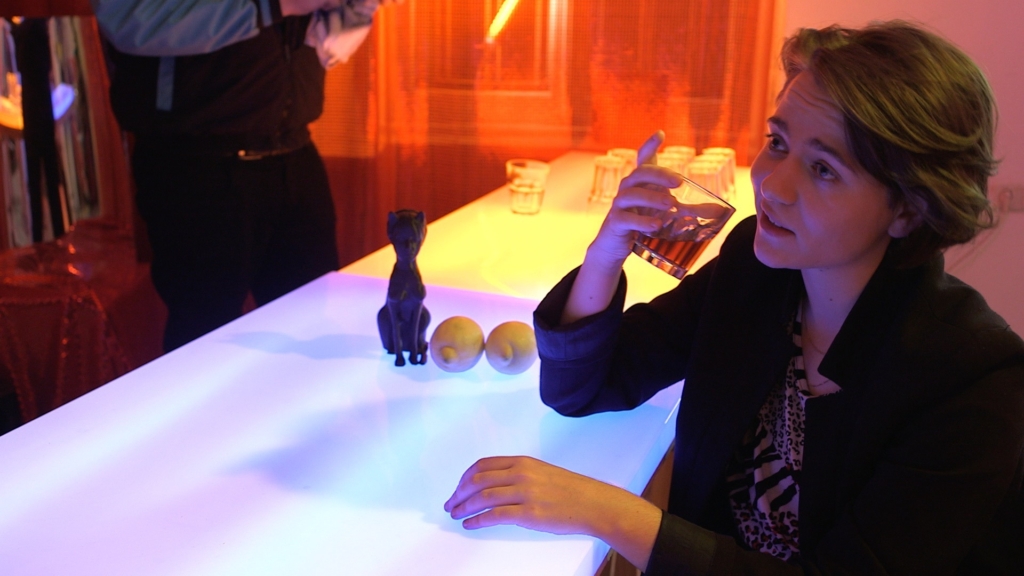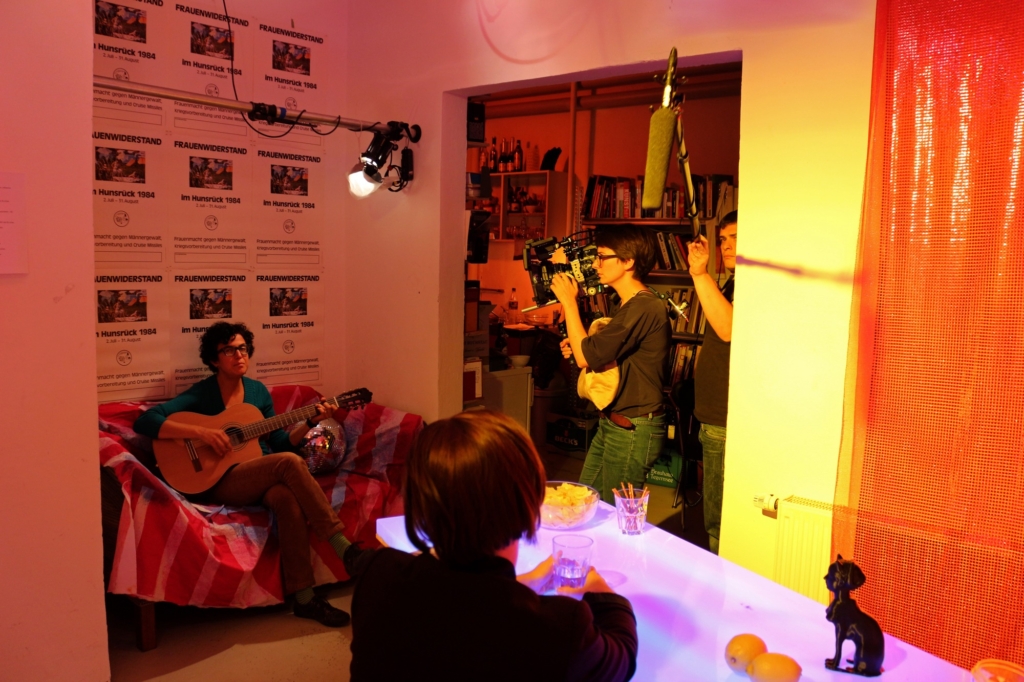DEDeutsch Text
Lothringer13_Florida hat immer am ersten Samstag des Monats von 12 – 18 Uhr geöffnet. Unsere Bibliothek, die sich aus deprivatisierten Buchbeständen speist und von der Library Group organisiert und aktualisiert wird, sowie unser Archiv und das Tonstudio sind dann besuchbar.
Diesen Monat präsentieren wir für alle, die beim offiziellen Screening am 12. November nicht dabei sein konnten, noch einmal Richard John Jones‚ Filminstallation ‚All Closing And Dyke Bar And Everything Ending And Not And Death To The Ahistoric Vacuum‚, Details zum Film im Anschluss. Wir freuen uns über Besuch!
Die Filminstallation entstand während einer Residency des Künstlers Richard John Jones im vergangenen Sommer in Lothringer 13_Florida. Ausgehend von der Recherche nach verlorenen lesbischen und schwulen Orten in München beinhaltete die Residency eine Tour mit Ariane Rüdiger auf der Suche nach verschwundenen lesbischen Orten, die Eröffnung einer temporären lesbischen Bar namens Moby Dyke, einen Auftritt der Künstlerin Cosy Pièro mit Meike Illig und die Digitalisierung von Materialien aus Cosy Pièros Privatbesitz, unter anderem Fotos aus Bei Cosy, ihrer berühmt-berüchtigten Künstlerkneipe während der Sechziger- und Siebziger Jahre. Ein Rückblick auf die Residency befindet sich hier.
Die Installation präsentiert einen Film, der am Ende der Residency produziert und im Moby Dyke gedreht wurde. Er beinhaltet Livemusik von Cosy Pièro und Meike Illig und eine Performance von Maximiliane Baumgartner und Mirja Reuter, die Teil ihres fortlaufenden, seriellen Projekts True Lives of Performers ist. Archivaufnahmen wurden dankenswerterweise vom Forum Homosexualität München zur Verfügung gestellt. Weitere Darsteller sind Maria Cincotta, Johanna Gonschorek, Philipp Gufler, Leo Heinik und Fabian Hesse.
- Regieassistent: Julian Curico
- Kamera: Julia Swoboda
- Ton: Colin Djukic
Jones schreibt über das Projekt:
Dieser Film entstand nach einer intensiven Recherche während einer Residency in Lothringer 13_Florida. In Zeiten, in denen lesbische und schwule Orte in vielen Ländern zunehmend verschwinden, stellt sich einerseits die Frage, wie diese verlorenen Orte erinnert werden können, andererseits aber auch, wie sich unsere Vorstellungen von Gemeinschaft und sozialen Räumen an die neuen Gegebenheiten anpassen müssen.
Die Handelnden im Film gehen eine Verbindung mit dem Recherchematerial ein, indem sie eine Reihe von Archiv- und Theorie-Texten nach-sprechen und nach-stellen. Während wir den Schauspielern durch den Raum folgen, werden wir Zeugen vieler kleiner Dramen, Tiefgründigkeiten, Erinnerungen oder Kontroversen, und obwohl man den Einduck hat, die Charaktere befänden sich alle zusammen im selben Raum, sind sie doch seltsam entfernt voneinander; zwar will jede/r gehört werden, doch kann keine/r wirklich in der Gruppe aufgehen. Für mich geht es dabei um den ewigen Konflikt zwischen der politischen Praxis, Räume zu besetzen, und dem Willen, diese zu teilen. Der Raum im Film ist nicht klar besetzt: Es könnte sich um um ein kleines Kino, eine Bar, einen Kunstraum oder eine Privatwohnung handeln. Ebenso ist die Zeitlinie des Films zyklisch angelegt und enthält mehrere Wiederholungen und Loops, was zu einem Gefühl der Des- oder Re-Orientierung beiträgt.
Der Film ist ein Experiment aus Assemblage und Reenactment als Strategie des Aufbrechens der Vorstellung von Erinnern als narrativer Struktur mit Anfang, Mitte und Ende. Stattdessen wollte ich erörtern, wie soziale Orte sich zwar zu einem bestimmten Zeitpunkt konstituieren, aber auf eine Weise einen politischen oder historischen Kontext stets entweder affirmieren oder zurückweisen.
ENEnglish Text
Lothringer13_Florida is open on every first Saturday of the month from 12 to 6pm. Our library consisting of deprivatized book collections organized and kept up to date by the Library Group and our archive and the sound studio can be visited during opening times.
This month we are presenting once more Richard John Jones‚ screening installation All Closing And Dyke Bar And Everything Ending And Not And Death To The Ahistoric Vacuum for all those who couldn’t make it to the official screening on November 12. Details as follows. We’d love to see you there!
This screening installation is one of the outcomes of a residency Richard John Jones conducted this past summer at Lothringer 13_Florida. Beginning with research into the lost lesbian and gay spaces in Munich, the residency included a tour of Munich’s lost lesbian venues by Ariane Rüdiger, the opening of a temporary lesbian bar called the Moby Dyke, a performance from artist Cosy Pièro and Meike Illig and the digitisation of photographs from Bei Cosy, a popular artist haunt throughout the 60s and 70s. A review of the various activities can be found here.
This installation showcases a film that was produced at the end of the residency and shot within the Moby Dyke. It features live music performed by the artist Cosy Pièro and Meike Illig and a performance by Maximiliane Baumgartner and Mirja Reuter which is part of their ongoing collaborative practice entitled True Lives of Performers. Archival footage included within the film is all courtesy of the Forum Homosexualität, Munich. The film also features performances by Maria Cincotta, Johanna Gonschorek, Philipp Gufler, Leo Heinik and Fabian Hesse.
- Assistant Director: Julian Curico
- Director of Photography: Julia Swoboda
- Sound: Colin Djukic
Jones writes of the project:
This film emerges from a period of research that was conducted while on a residency at Lothringer 13 Florida. In a time when queer, lesbian and gay social spaces are rapidly closing down in many countries there is a question of how these lost spaces can be remembered but also how ideas of sociality and social space need to be updated.
Drawing on the research material, the characters in my film are re-voicing, re-performing or re-enacting a variety of archival and theoretical texts. As we follow these actors through the space, we are witness to many small dramas, profundities, recollections or controversies and although there is a sense that the characters are all together in one venue they seem distant from one another, each with an urgency to be heard whilst not fully connecting themselves with the group as a whole. To me this is about this eternal conflict between the politics of occupying space and the notion of sharing it. The space of the film is also ambiguous (it could be anything from a small cinema to a bar, or a art space or private home). The timeline of the film is also cyclical and contains many internal repetitions and loops contributing to a sense of disorientation/reorientation.
The film is an experiment of assemblage and re-enactment as a strategy for queering ideas of memory going beyond narrative form as having a beginning, middle and end. Instead, I wanted to consider how social spaces are constituted within a particular moment but somehow always formed from an identification or rejection of a political or historical context.












